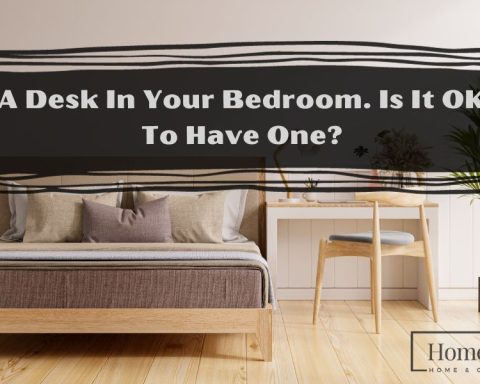Imagine enjoying a summer day without bugs or too much sun. That’s what a screened porch offers. It’s the perfect blend of indoors and outdoors.
These porches have been here for decades, where neighbors wave from their front steps.
But is it a good idea for your home? Does it add harmony without compromising comfort and convenience? Well, a screened-in porch could be the perfect solution for you.
This blog post will discover how a screened-in front porch could be a practical addition to your home.
A screened-in front porch is a good idea because it allows you to enjoy nature without drawbacks. Screened porches effectively extend your living space.
Thus, providing an extra area for relaxation, dining, or even work. In addition, a screened-in porch can potentially increase your home’s value.
However, it also involves significant investment, regular cleaning, and maintenance. As well as that, it reduces the amount of natural light entering your home.
What Is a Screened-In Porch?
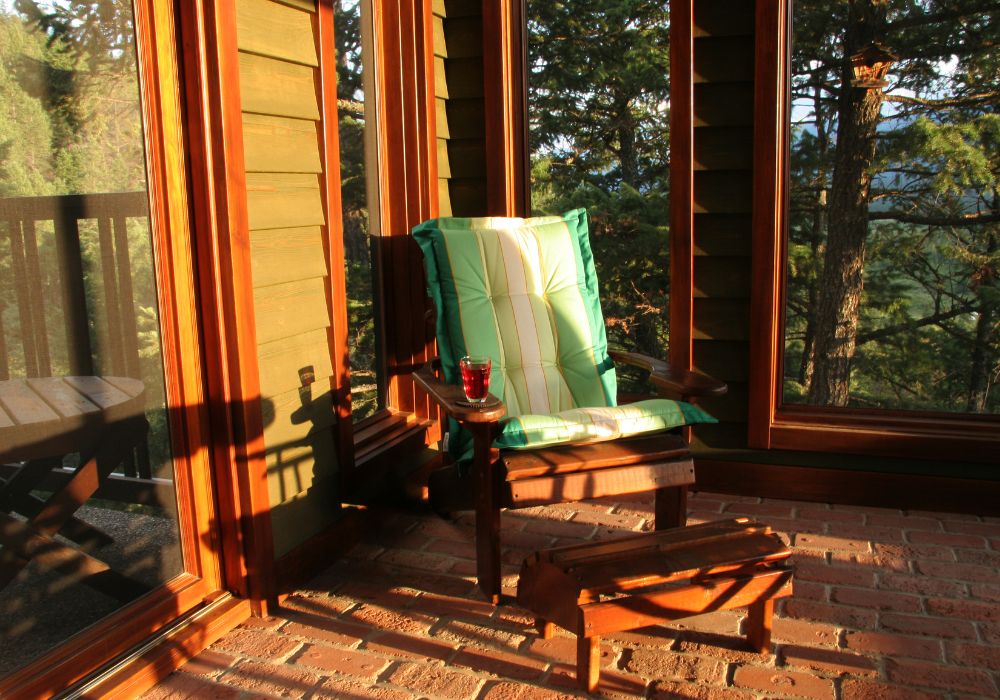
A screened-in porch is also known as a screened porch or screened patio. It is a covered outdoor living space enclosed with mesh or screen walls.
It serves as a transitional area between the interior and exterior of a house.
In addition to that, a screened-in porch offers the best of both worlds—the enjoyment of the outdoors with some of the comforts of being indoors.
As you can see, the primary purpose of a screened-in porch is to provide an open-air space for homes. It allows residents to experience nature while protecting them from pests & adverse weather.
Key Features of a Screened-In Porch
Screen Enclosure: Screened-in porch walls are primarily made of mesh or screens. These screens are typically made from durable materials like fiberglass or aluminum. These are tightly woven to prevent insects and debris from entering the space.
Roof: These are typically covered by a roof that protects them from rain and sunlight. Thus, allowing it to be widely used in various weather conditions.
Flooring: The flooring of a screened-in porch can vary. However, it is usually made of weather-resistant materials like concrete and brick. At the same time, it is also created through stone or treated wood.
Entryway: A screened-in porch usually has one or more entry points. These are often connected to the house’s main living area or accessible from the front or back yard.
Is A Screened In Front Porch A Good Idea?
Yes, a screened-in front porch can be a fantastic idea for many homeowners. It offers several benefits that make it a worthwhile addition to any home.
Here are some reasons why a screened-in front porch can be a great idea:
Enhanced Outdoor Experience
It allows you to enjoy the outdoors without worrying about insects & harsh weather elements. It provides a sheltered space where you can relax, read a book, or soak in the sights and sounds of nature.
Increased Curb Appeal
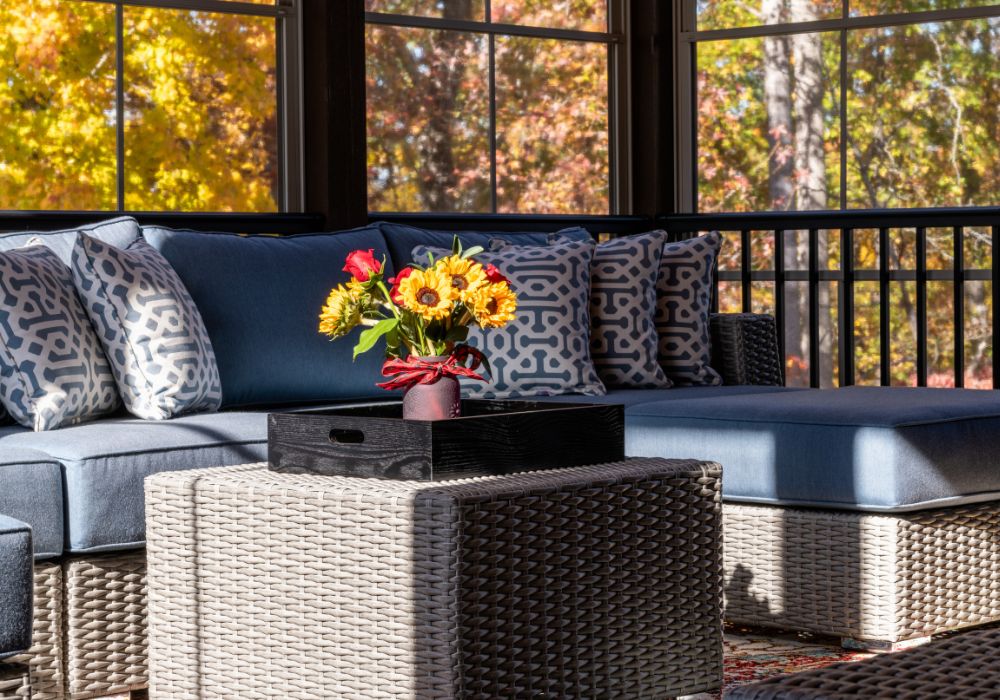
An aesthetically pleasing screened-in front porch can enhance your home’s curb appeal. It creates a welcoming and inviting atmosphere.
Thus, it makes your property more attractive to visitors. As well as that, it can captivate potential buyers if you decide to sell in the future.
Versatility
A screened-in front porch is a versatile space that can serve various purposes. It can be an excellent spot for morning coffee or afternoon tea.
At the same time, it can be a room for evening gatherings with friends and family.
Health and Well-Being
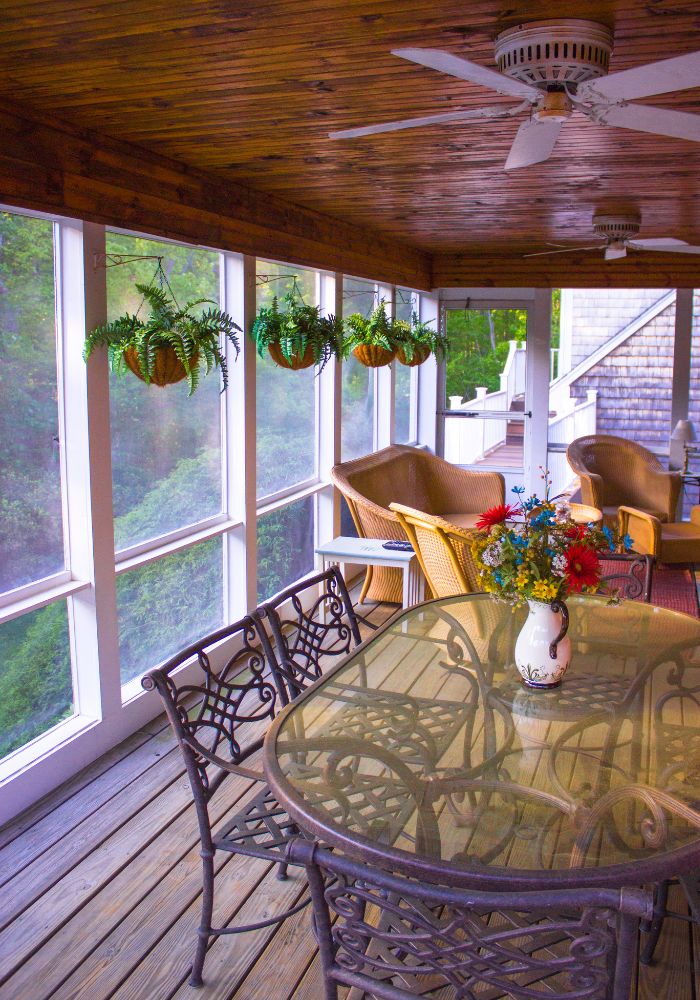
Spending time on a screened-in front porch allows you to be highly protected from harmful UV rays. You are, in nature, linked to reduced stress levels & improved mental well-being.
Therefore, having a peaceful outdoor sanctuary can positively impact your overall health.
Energy Efficiency
It can provide shade and reduce the amount of direct sunlight entering your home. This, in turn, can lead to lower cooling costs during hot summer months.
As a result, it makes it an energy-efficient addition to your property.
Privacy
A screened-in front porch can offer a sense of privacy and seclusion. It allows you to enjoy outdoor living without feeling too exposed to neighbors.
While a screened-in front porch offers numerous advantages, there are also considerations. Here are a few factors to consider before making the decision:
Budget
The cost of building a front porch into a screened-in one can vary on the size, materials, and design. It’s essential to establish a budget and plan accordingly.
Maintenance
Screened porches require regular cleaning and maintenance. Homeowners need to keep them looking good and functioning well. The screens may also need to be frequently replaced over time.
Local Regulations
Check with your local authorities about any building codes or regulations. You should apply these restrictions when adding a screened-in porch.
Climate
Consider your local climate and weather conditions. Yes, a screened-in porch is suitable for mild to moderate climates. However, it may not be as helpful in extreme weather conditions like snowfall or heat waves.
How Much Does the Average Screened-In Porch Cost?
According to Forbes, the standard cost to build an entire screened-in porch is $32,400. On the other hand, the cost of screening on a pre-existing porch varies between $3,200 and $5,800.
Screened-In Front Porch Cost Breakdown
Screen Material
Durable and energy-efficient fiberglass is a common choice, priced between $3.15 to $3.90 per sqft.
Labor
Labor costs will likely incur if you opt for professional help to build a new porch or add a roof. However, adding screens to an existing patio may save approximately $2 per sqft.
Complex Designs
The complexity of your project will impact material costs. Thus, more intricate designs lead to higher expenses. For example, the cost of porch steps ranges from $300 to $1,900, primarily determined by the size of the staircase.
Building Permits
Permit costs average around $800, ranging from $100 to $3,900, depending on your location. Additionally, you may incur approximately $500 for land surveying services.
What Is the Cheapest Way To Build a Screened-In Porch?
The cheapest way to build a screened-in porch involves cost-saving measures and DIY efforts. You can create an affordable one by focusing on budget-friendly materials and DIYs.
As a result, it won’t even compromise on quality or functionality.
Here are some tips to help you achieve this:
DIY Labor
If you have the necessary skills and experience, take on some labor yourself. Handling tasks like painting, landscaping, or installing screens can reduce labor costs.
Choose Cost-Effective Materials
Opt for affordable yet durable materials that can help cut down expenses:
- Pressure-treated lumber for framing
- Basic screening material
- Simple roofing options
Utilize Existing Structure
If you have an existing patio or deck, consider using it as the foundation for your screened-in porch. Converting an existing structure can save significant costs compared to building from scratch.
Opt for Simple Designs
Choose a straightforward and uncomplicated design for your screened porch. Complex designs can increase construction costs due to additional materials and labor.
What’s the Best Size For a Screened-In Porch?

The best size for a screened-in porch is 14×16 feet. It is a popular size balancing spaciousness and manageability.
A larger size is necessary for those desiring a standard dining set and a U-shaped lounge area. We suggest choosing at least 24 x 14 feet to accommodate dining and living spaces.
Considerations on ideal dimensions for your screened porch:
Available Space: Assess the available space in your yard or the area where you plan to build the porch. Consider any existing structures or property lines that may influence the porch size.
Intended Use: Think about how you plan to use the screened porch. A smaller size may suffice if you envision it as a space for quiet relaxation or intimate gatherings. Meanwhile, if you intend to entertain large groups, a larger size may be more suitable.
Furniture and Layout: Consider your furniture’s size and arrangement. Ensure there is enough space for the elements you wish to incorporate.
What Is the Difference Between a Screened-In Porch And a Patio?
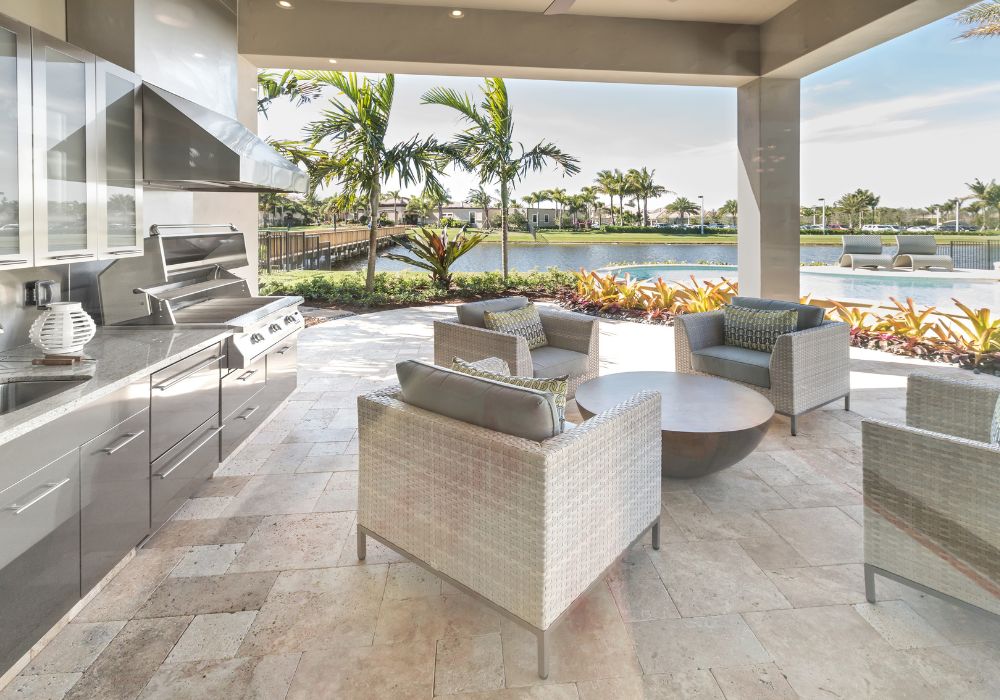
A screened-in porch is a covered outdoor space enclosed with screen walls. At the same time, a patio is an outdoor area without enclosing walls or screens.
Screened-in porches serve as an extension of the main house. Thus, making it accessible through a door from the interior living areas. The enclosed nature of this makes it suitable for year-round use in moderate climates.
It provides a seamless transition between indoor and outdoor living. It also offers versatility & accommodating activities like dining, relaxing, reading, and entertaining.
Meanwhile, a patio is a hard-surfaced space that extends from the house. It is typically situated at ground level. Unlike a screened-in porch, a patio is fully exposed to the elements like weather & sunlight.
They are commonly used as outdoor living and entertaining spaces. Some examples are grilling, hosting gatherings, and engaging in open-air activities. As you can see, patios lack enclosed convenience, but they offer freedom in design and usage.
How Long Do Screened Porches Last?
A general estimate suggests a screened porch may last around 6 to 8 years. In most cases, it is possible to extend its longevity with proper care and maintenance.
Here are some tips for proper screened porch maintenance:
- Regular Cleaning: Sweep the floor and wipe down surfaces regularly to remove dirt. Clean the screens to prevent dirt buildup and maintain clear views.
- Inspect for Damage: Regularly inspect the porch’s structure, screens, and roofing. Look for wear, tear, or damage, such as loose screens, damaged frames, or leaks.
- Repair Any Issues Promptly: Immediately address any damage or issues found during inspections. Replace damaged screens, repair loose frames, and fix leaks to prevent further deterioration.
- Weatherproofing: Apply weatherproof sealants or coatings. Ensure that it is highly protected from moisture and other weather-related damage.
- Trim Surrounding Vegetation: Trim nearby bushes and trees regularly. This is to prevent branches from damaging the screens.
- Maintain Proper Drainage: Ensure that the porch has proper drainage. Remember to check proper water accumulation and potential moisture-related problems.
Do Screened-In Porches Get Dirty?
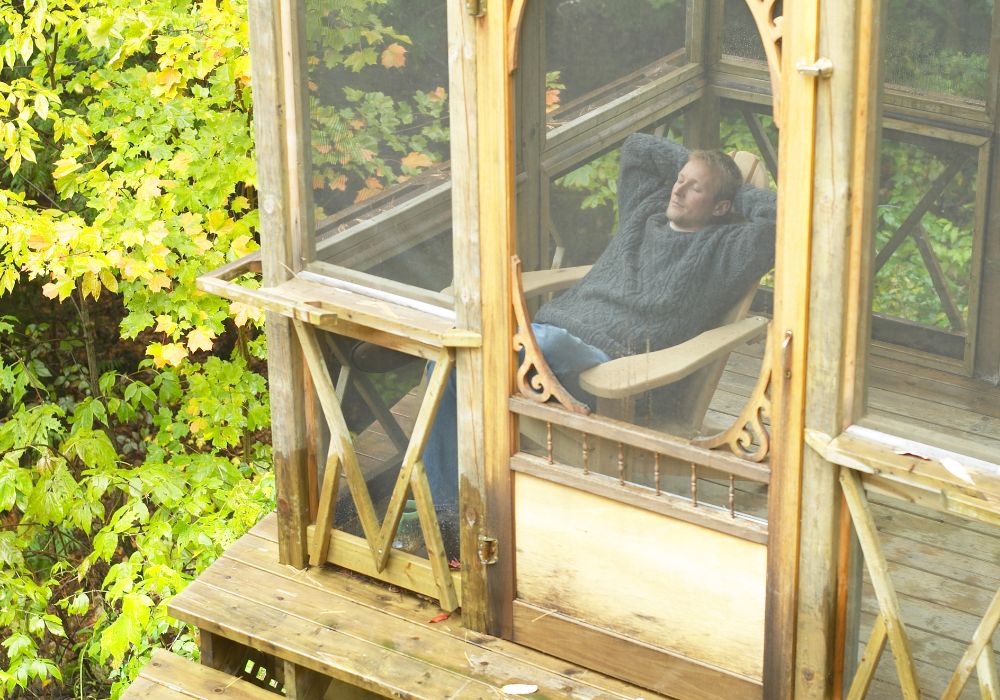
Yes, screened-in porches can get dirty over time. While screens protect against debris, they are not completely impenetrable to dirt.
As mentioned earlier, porches are generally situated outdoors. Therefore, it is inevitably exposed to factors that contribute to the growth of dirt and dust.
Windblown dirt, dust, and pollen can find their way into the porch through tiny gaps in the screens. Fallen leaves, twigs, and seeds carried by wind gusts can also contribute to debris buildup.
Additionally, insects like flies, gnats, or moths may slip through openings. Their presence can leave behind traces of droppings, webs, or discarded wings.
Frequent foot traffic and the presence of pets can also contribute to gradual soiling. Dirt and shoe dust can accumulate on the floor, making it more susceptible to dirtiness.
Weather conditions, such as rain or strong winds, can play a significant role. Rainwater can carry dirt and mud, splattering it on the screens. Meanwhile, strong winds carry airborne particles that find their way through the mesh.
Regular cleaning and maintenance are essential to maintain a clean and inviting space. By staying vigilant, homeowners can ensure that porches remain a pleasant outdoor sanctuary.
Does a Screened-In Porch Keep In Heat?
A screened-in porch does not keep in heat like a fully enclosed room or insulated space. It is not designed to retain heat in the same way as an enclosed room.
However, there are some effective ways to heat a screened-in porch:
Electric Space Heaters are the most popular and convenient options for heating a screened-in porch.
Portable Electric Space Heater
Infrared Heaters – These are energy-efficient and provide gentle heat without extensive warmth.
Outdoor Propane Heaters – These are freestanding, tabletop, or mounted models.
Fire Pit or Chiminea – Adding a fire pit or chiminea can provide heat and a cozy focal point for gatherings.
Outdoor Blankets and Throws – Keep cozy blankets and throws on hand for guests to wrap themselves in for added warmth.









